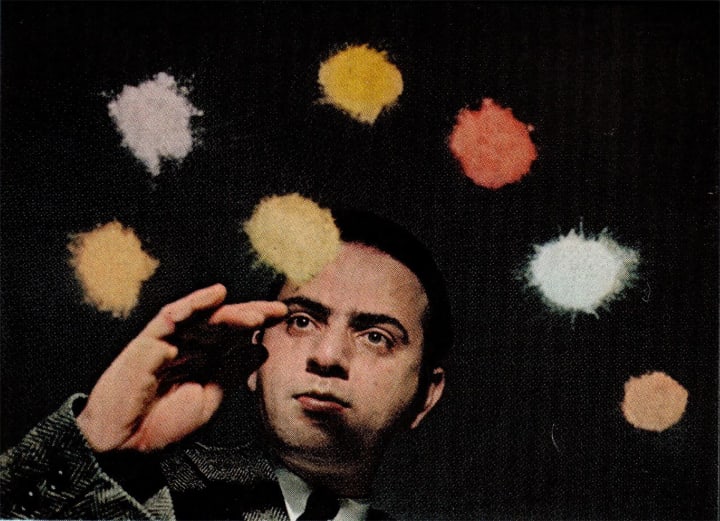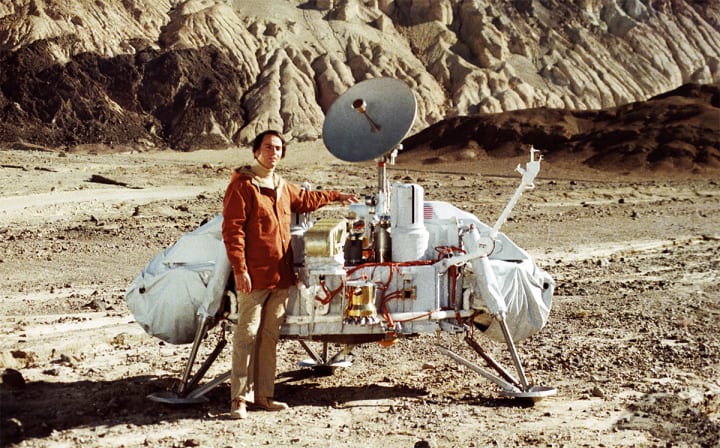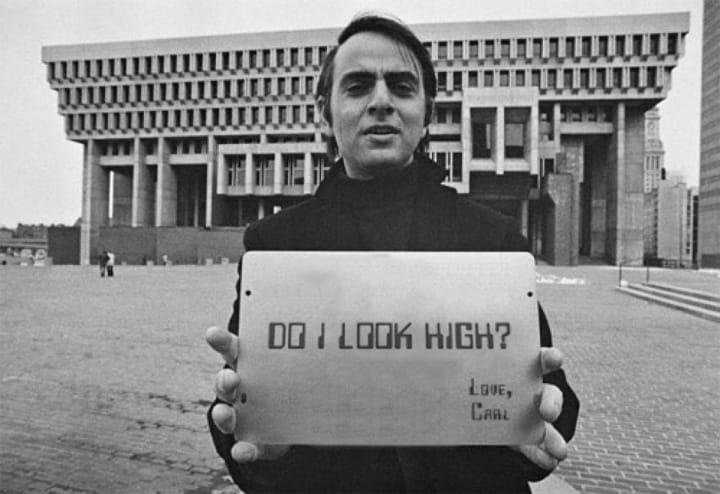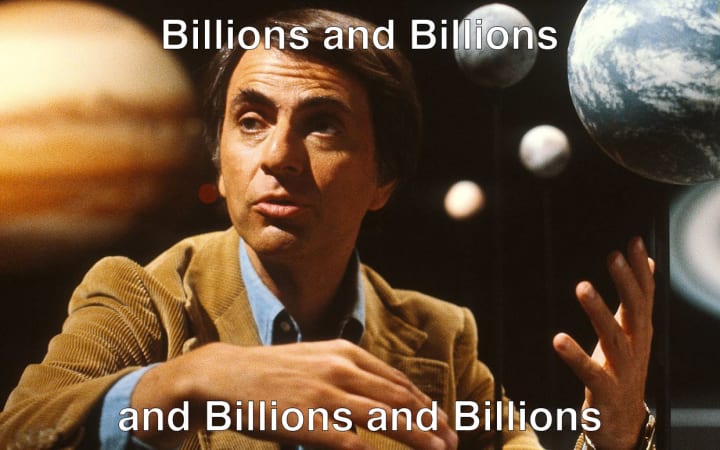Carl Sagan Inspired Curiosity
The face of curiosity was Carl Sagan, a pioneer that echoed the importance of science as a source of inspiration.
Carl Sagan's enthusiasm and ability to convey ideas, such as humanity's place in the universe against the backdrop of a cosmic scale, inspired countless people to pursue their own curiosity. As the author of more than 600 scientific papers, editor of more than 20 books, and creator of Cosmos: A Personal Voyage, Sagan worked tirelessly to push science into the spotlight. He advocated heavily for scientific skeptical inquiry, pioneered exobiology, and promoted the Search for Extraterrestrial Intelligence (SETI). The name Sagan is inseparable from the word "curious."
Early Life

Image via Reda Galleries
Born in Brooklyn, New York, Sagan's father was an immigrant garment worker from Ukraine and his mother was a local New Yorker. He expressed analytical thinking and a fascination with nature at an early age. Sagan recalled the 1939 World's Fair as inspirational to his scientific pursuits, 'Plainly, the world held wonders of a kind I had never guessed. How could a tone become a picture and light become a noise?' Sagan would hone his curiosity at the University of Chicago where he earned a PhD in astronomy and astrophysics in 1960. He moved on to teach at Cornell University in Ithaca, New York.
"Somewhere, something incredible is waiting to be known" - Carl Sagan
Looking to the Stars

Academia was not Sagan's only home. He worked as an adviser to NASA, and helped create many of the robotic spacecraft sent on missions to explore the Solar System. It was his idea to send an unalterable, and universal, message into the vastness of space. The physical message was embedded on a golden-anodized plaque and attach to Pioneer 10, which launched in 1972. It is hoped that one day intelligent extraterrestrials may discover the plaque in another planetary system and decipher humanities place in the universe. Radio communications were lost with Pioneer 10 on January 23, 2003 because of the loss of electric power for its radio transmitter. The probe was at a distance of 12 billion kilometers (80 AU) from Earth.
'There will be no humans elsewhere. Only here. Only on this small planet. We are a rare as well as an endangered species. Every one of us, in the cosmic perspective, precious. If a human disagrees with you, let him live. In a hundred billion galaxies, you will not find another' - Carl Sagan
Making His Mark in the Universe

image via Amazon
The esteemed astrophysicist wrote extensively and many his writings appeared in many sources outside of the academic community. In the August 1979 issue of OMNI Magazine Sagan wrote about little green men and rockets. He discussed the notion that extraterrestrials may have visited the Earth before recorded history or in the early stages of human development 40 years before the History Channel aired Ancient Aliens and Chariots of the Gods. Working with Soviet astrophysicist I.S. Shlovskii, Sagan explored the notion in their collaborative book Intelligent Life in the Universe, where they 'examined a range of artifacts, legends, and folklore from many cultures and concluded that not one of these cases provided even moderately convincing evidence of extraterrestrial contact.' So much for the Fermi paradox.
Contact

Image via NASA
Beyond debunking ancient aliens, Sagan was heavily involved in the UFO question. While he did not give much credit to the notion that UFO's were of an extraterrestrial origin he believed scientists ought to study them considering the widespread public interest in the phenomenon. While he was fascinated with the thought experiment of alien visitors, as highlighted in Sagan's book Contact (later turned into a film starring Jodie Foster and James Woods), Sagan argued that the chances of extraterrestrials mastering interstellar travel and visiting Earth was minuscule. He did believe it plausible that governments mislead their citizens by hiding behind UFO's among Cold War concerns.
Cosmos

Image via eskipaper.com
On September 28, 1980, Carl Sagan took audiences across America on a 13-part journey through time and space through the television show Cosmos, based on the book of the same name. The scientific discovery television show left a legacy that continues to inspire today. Sagan sits in a Wellsian spaceship, and pilots it. While the Pulitzer Prize winning author was working as a scientist for the Viking Mars mission he became annoyed by uninformed reporting of historical and scientific events. In his own words he said the purpose of Cosmos"[was] to bring science to the public in an accurate and enthusiastic manner." His other cause was to inspire young and old to recognize the importance of exploring the solar system, the need to fill people with wonder and excitement at the prospect of venturing into the unknown.
Cosmos was a monumental success, in part due to innovative video effects that visualized a stellar journey past quasars, black holes, asteroid belts, and galaxies. New special effects linking computers and camera systems allowed the show to place as many as six galaxies in correct spatial relation to one another. Cosmos became of a symbol of a desire to learn. It endeared so well that in Seth MacFarlene and Ann Druyan produced Cosmos: A Spacetime Odyssey in 2014, with astrophysicist Neil deGrasse Tyson hosting. The show served as a follow-up to the original series, following a similar format but with updated information since the 1980s. The show is available for streaming through Netflix.
The Stoner Scientist

Image via Guardian Liberty Voice
Under the pseudonym 'Mr. X,' Sagan contributed an essay about smoking cannabis to the 1971 book Marihuana Reconsidered. As a user and advocate of cannabis, Sagan expressed how the use of the plant helped inspire his work and enhance his sensual and intellectual experiences. His identity as 'Mr.X' was not revealed until after his death in the biography, Carl Sagan: A Life. His widow, Ann Druyan, presides over the board of directors of the National Organization for the Reform of Marijuana Laws (NORML), a non-profit organization dedicated to reforming cannabis laws.
'The surface of the Earth is the shore of the cosmic ocean. On this shore, we've learned most of what we know. Recently, we've waded a little way out, maybe ankle-deep, and the water seems inviting. Some part of our being knows this is where we came from. We long to return, and we can, because the cosmos is also within us. We're made of star stuff. We are a way for the cosmos to know itself.' - Carl Sagan
Death and Beyond

Image via Art.com
After suffering from Myelodysplasia, a blood-related medical condition, Sagan died of pneumonia at the age of 62. While his voice has left the Earth, his legacy continues to ring loudly as a call to action for scientific pursuits. Sagan did what few other advocates of science have been able to accomplish. He captured the poetry of science and conveyed it simply and enthusiastically so that every person listening to him him could not help but feel excitement at the prospect of knowledge. Isaac Asimov once said that Carl Sagan was one of two people he ever met whose intellect surpassed his own.
Sagan the Meme King

Image via Google
Side note: Sagan quotations and memes circulate the web as often as pictures of cats. He reminds humanity to look up, to question, to never be satisfied with half-truths. It was Sagan who reminded humanity that they are made from the stars, 'We are a way for the cosmos to know itself.'
About the Creator
George Gott
Writer & Social Media Editor for Jerrickmedia who is an avid reader of sci-fi and a fierce defender of women, minority, and LGBTQ rights.






Comments
There are no comments for this story
Be the first to respond and start the conversation.